
Mu Cephei, also known as Herschel's Garnet Star, Erakis, or HD 206936, is a red supergiant or hypergiant star in the constellation Cepheus. It appears garnet red and is located at the edge of the IC 1396 nebula. Since 1943, the spectrum of this star has served as a spectral standard by which other stars are classified.

W Sagittarii is a multiple star system star in the constellation Sagittarius, and a Cepheid variable star.
KW Sagittarii is a red supergiant, located approximately 1,900 parsecs away from the Sun in the direction of the constellation Sagittarius. It is one of the largest-known stars. If placed at the center of the Solar System, the star's surface would engulf Mars.

V354 Cephei is a red supergiant star located within the Milky Way. It is an irregular variable located over 13,000 light-years away from the Sun. It has an estimated radius of 1,139 solar radii. If it were placed in the center of the Solar System, it would extend to between the orbits of Mars and Jupiter.

Zeta Cephei is a star in the constellation of Cepheus. Zeta Cephei marks the left shoulder of Cepheus, the King of Joppa (Ethiopia). It is one of the fundamental stars of the MK spectral sequence, defined as type K1.5 Ib.

W Cephei is a spectroscopic binary and variable star located in the constellation Cepheus. It is thought to be a member of the Cep OB1 stellar association at about 8,000 light years. The supergiant primary star is one of the largest known stars and as well as one of the most luminous red supergiants.
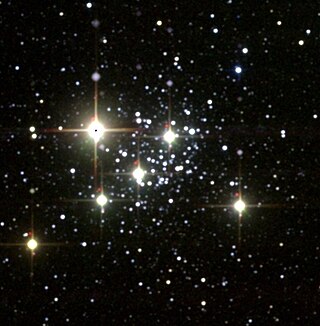
MY Cephei is a red supergiant located in open cluster NGC 7419 in the constellation of Cepheus. It is a semiregular variable star with a maximum brightness of magnitude 14.4 and a minimum of magnitude 15.5.
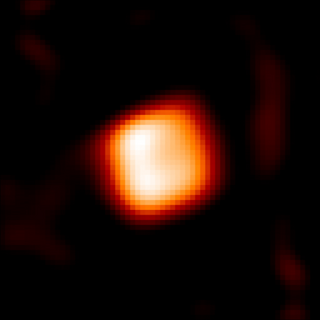
RW Cephei is a K-type hypergiant and a semirregular variable star in the constellation Cepheus, at the edge of the Sharpless 132 H II region and close to the small open cluster Berkeley 94. It is among the largest stars known with a radius of almost 1,000 times that of the Sun (R☉), nearly as large as the orbit of Jupiter.

V381 Cephei is a triple star system in the northern constellation of Cepheus. Its apparent magnitude is slightly variable between 5.5 and 5.7.

WR 22, also known as V429 Carinae or HR 4188, is an eclipsing binary star system in the constellation Carina. The system contains a Wolf-Rayet (WR) star that is one of the most massive and most luminous stars known, and is also a bright X-ray source due to colliding winds with a less massive O class companion. Its eclipsing nature and apparent magnitude make it very useful for constraining the properties of luminous hydrogen-rich WR stars.
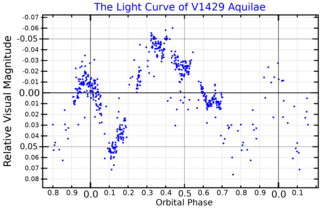
V1429 Aquilae is a candidate luminous blue variable multiple star system located in the constellation of Aquila. It is often referred to by its Mount Wilson Observatory catalog number as MWC 314. It is a hot luminous star with strong emission lines in its spectrum.

KQ Puppis is a spectroscopic binary located about 2,700 light-years from Earth in the constellation Puppis. A red supergiant star and a B-type main-sequence star orbit each other every 27 years. Its apparent magnitude varies between 4.82 and 5.17, making it faintly visible to the naked eye.

HR 5171, also known as V766 Centauri, is a yellow hypergiant in the constellation Centaurus. It is said to be either an extreme red supergiant (RSG) or recent post-red supergiant (Post-RSG) yellow hypergiant (YHG), both of which suggest it is one of the largest known stars. The star's diameter is uncertain but likely to be between 1,100 and 1,600 times that of the Sun, while its distance is 3.6 kpc from Earth. According to a 2014 publication, the star is a contact binary, sharing a common envelope of material with a smaller yellow supergiant and secondary star, the two orbiting each other every 1,304 ± 6 days.

W Crucis is a single-lined eclipsing variable star system in the constellation Crux. It has a spectral class of F8/G1Ia/abe indicating a yellow supergiant with emission lines in its spectrum.

WR 30a is a massive spectroscopic binary in the Milky Way galaxy, in the constellation Carina. The primary is an extremely rare star on the WO oxygen sequence and the secondary a massive class O star. It appears near the Carina Nebula but is much further away.
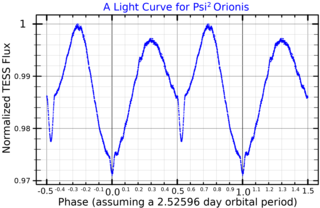
Psi2 Orionis a binary star system in the equatorial constellation of Orion. It has an apparent visual magnitude of 4.6, indicating that it is visible to the naked eye. Based upon an annual parallax shift of 2.87 mass, it is roughly 1,100 light years distant from the Sun.

U Lacertae is a spectroscopic binary star in the constellation Lacerta.
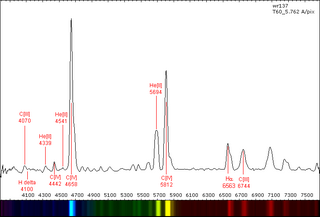
WR 137 is a variable Wolf-Rayet star located around 6,000 light years away from Earth in the constellation of Cygnus.

VV Orionis is an eclipsing binary located in the belt region of the constellation Orion. It is a faint naked eye star.
WY Geminorum is a binary star system in the northern constellation of Gemini, abbreviated WY Gem. It has an apparent visual magnitude that ranges from 7.26 down to 7.51, which is too faint to be readily viewed with the naked eye. This system is located at a distance of approximately 6,300 light years from the Sun based on parallax measurements, and is receding with a radial velocity of 19.5 km/s.

















